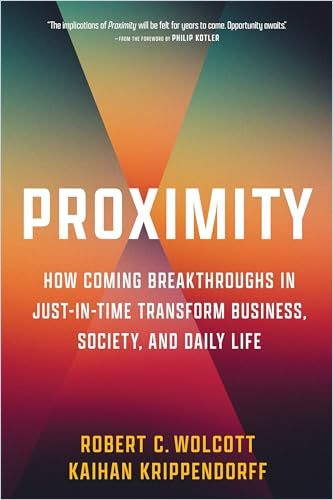Business consultants Kaihan Krippendorff and Robert C. Wolcott provide a heady, dazzling portrait of a future in which demand and delivery happen instantly.

Tomorrow’s Proximity Today
Business consultants Kaihan Krippendorff — founder of the global think tank Outthinker Networks — and Robert C. Wolcott — co-founder and chair of The World Innovation Network, and University of Chicago professor of innovation — explain how digital technologies and global trends in work, health care, food, energy, and defense will soon enable you to customize and receive instant delivery of any product or service.
Proximity
Proximity means that value creation — production and delivery of products, services, and experiences — and customer ready-to-pay demand — grow ever more proximate in space and time. At some future moment, known as Proximity = 0 (P = 0), people will instantly convert raw materials into goods and services at their moment of demand.
Imagine a world in which each desire is satisfied at zero cost with zero environmental impact immediately at the moment of demand.Krippendorff and Wolcott
Streaming services, for example, let you watch media content on demand — instant value provision. Generative AI technologies allow you to create on-demand text, audio, and visuals — instant value production.
Technologies such as AI and robots enable data collection, analysis, and coordination — bringing value creation nearer to customer demand. Krippendorff and Wolcott argue that companies’ abilities to create personalized products at scale will improve as data capture, storage, and analytics technologies improve and grow less expensive.
Digital technologies enable Proximity, but won’t ensure its growth. Pandemics, geopolitics, climate risks, and space travel might. During the COVID-19 pandemic, for example, digital technologies kept economies afloat, with virtual meetings allowing businesses and schools to remain open and bioplatforms enabling rapid vaccine development.
Proxy AIs — digital simulations trained on public or private data — will enable companies to call upon domain experts or even historical figures for help with problems. Krippendorff and Wolcott speculate that experts may create digital copies of themselves, allowing them to exist and function simultaneously in several places.
Food Proximity means people will no longer have to rely on large, centralized farms and global supply chains to produce processed foods in locales far from demand. Proximity brings sustainable, ethical, and customized food production nearer to consumers.
Expect AI-enabled design and automated, distributed production to converge over the next few decades. Their mature power will arise from designing and producing what’s special to the moment at hand.Krippendorff and Wolcott
Controlled Environment Agriculture (CEA), for example, allows you to grow tropical crops and leafy greens indoors in cold environments with 90% less water than conventional agriculture demands.
Proximity in health care focuses on personalized medicine. Imagine, for example, using low-cost DNA sequencing to create small batches of medications tailored to your genetic profile.
Wearables — such as the Oura Ring, which monitors sleep, stress, heart rate, and body temperature — and implantables — rice-grain-sized microchips that hold blood type, medications, and other health information — can monitor your health 24/7, alerting you to potential health complications, and storing essential data for doctors to access.
Production, Power, Defense
Proximity in producing and creating goods means shifting toward smaller, distributed factories storing raw materials closer to customers, Krippendorff and Wolcott write. When an order comes in, 3D printing transforms the raw materials into a finished product built to customer specifications. For example, Ford printed 500,000 replacement parts as of 2022.
Proximate power shifts energy production toward clean, localized energy sources, characterized by the 4Ds: decarbonized, distributed, digital, and democratic — accessible to everyone. Wind farms, rooftop solar, and other distributed energy resources (DERs) can connect to form virtual power plant (VPP) networks. AutoGrid, for example, manages 5,000 megawatts of energy in VPPs across 12 countries using Amazon Web Services.
Despite the benefits of 4D power, only 20% of the world’s power comes via electricity, and most clean energy relies on fossil fuels for generation. However, advancements in battery storage bring clean energy storage closer to ultimate demand. According to Krippendorff and Wolcott, battery minerals will become as crucial this century as fossil fuels were in the past century.
As satellites, sensors, and AI enhance intelligence gathering, and weaponry becomes more precise — such as today’s drones capable of striking targets from 50,000 feet [15 kilometers] with minimal collateral damage — military units must become smarter, faster, and more distributed.
Attention and Desire
The digital technologies that enable Proximity create an ever-more virtual world. “Smart lenses” in human eyes, and enhanced computing for the metaverse, for example, blur the line between real and virtual.
In this emerging landscape, human attention and desire become paramount. Companies exploiting personal data to predict demand and serve customers will become more invasive, featuring, for example, mapped genomes and brain scans.
As digital technologies remove Proximity’s constraints, the world will shift toward producing and providing value closer to customer demand. For example, Amazon spent 10% of its profits to build fulfillment centers near consumers. In 2021, 77% of Americans lived within an hour of one of these centers.
Fortune favors the proximate.Krippendorff and Wolcott
Strategize your organization’s “Proximity leap”: envision P = 0 in your industry — imagine how immediate value creation and delivery might look. Identify barriers to P = 0 that, if solved, would further your creating and delivering value on demand. Recognize trends that could overcome those barriers. Brainstorm opportunities based on these barriers and trends, evaluating their business impact, required effort, and likelihood of success.
Heady Stuff
Kaihan Krippendorff and Robert C. Wolcott offer a dizzying vision of future possibilities for satisfying any consumer urge, including instant medicine and food production. The pair seems to understand that proceeding at a breakneck pace — with “gee whiz!” prophecies of future Proximity wonders and ultra-specific examples of its current manifestations flying by like meteorites — may help readers to suspend disbelief about some of their more grandiose predictions. But regardless of whether the full universe of Proximity ever comes to pass, they provide a fun-filled read.












